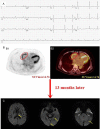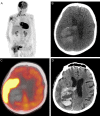Stroke and molecular imaging: a focus on FDG-PET
- PMID: 37214267
- PMCID: PMC10193198
Stroke and molecular imaging: a focus on FDG-PET
Abstract
Stroke is the leading cause of disability worldwide, the second most common cause of dementia and the third leading cause of death. Though the etiology of stroke has been explored extensively, there remains open questions in the scientific and clinical study of stroke. Traditional imaging techniques, such as magnetic resonance imaging and computed tomography, have been applied extensively and remain mainstays in clinical practice. Nevertheless, positron emission tomography has proven to be a powerful molecular imaging tool in exploring the scientific aspects of neurological disease, and stroke remains an area of great interest. This review article examines the role of positron emission tomography in the study of stroke including its contributions to elaborating related pathophysiology and delving into possible clinical applications.
Keywords: PET; infarction; ischemic stroke; molecular imaging; stroke.
AJNMMI Copyright © 2023.
Conflict of interest statement
None.
Figures




References
-
- Tadi P, Lui F. StatPearls. Treasure Island (FL): StatPearls Publishing Copyright © 2022, StatPearls Publishing LLC.; 2022. Acute Stroke.
-
- Lovblad KO, Altrichter S, Mendes Pereira V, Vargas M, Marcos Gonzalez A, Haller S, Sztajzel R. Imaging of acute stroke: CT and/or MRI. J Neuroradiol. 2015;42:55–64. - PubMed
Publication types
Grants and funding
LinkOut - more resources
Full Text Sources
